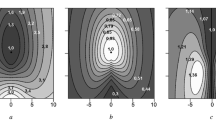Abstract
Employing the “statistical thermodynamic formalism” developed in an earlier paper, it is possible to determine “compact” sets of transmission times for the words of PCM (pulse code modulation) messages. In particular, we deal with pulses of zero or unit heights. These compact signals, which lead to shorter message times and eliminate redundancy even when successive words are correlated (Markov source), may, however, require additional bandwidth. We examine two simple cases where autocorrelation functions, and therefore power spectra, can be evaluated. In one case, that of the Markov source, it proves possible to accomplishboth shorter transmission time and narrower bandwidth (half-width of the power spectrum), showing that optimization of transmission times can be very worthwhile. Techniques for deriving autocorrelation functions are discussed at length.
Similar content being viewed by others
References
H. Reiss and C. Huang, Statistical thermodynamic formalism in the solution of information theory problems,J. Stat. Phys. 3(2):191 (1971).
C. E. Shannon, Communication in the presence of noise,Proc. IRE 37:10 (1949).
K. W. Cattermole,Principles of Pulse Code Modulation (Elsevier, New York, 1969).
S. W. Golomb,Digital Communications with Space Applications (Prentice-Hall, New Jersey, 1964), p. 12.
D. A. Huffman, A method for the construction of minimum redundancy codes,Proc. IRE 40:1098 (1952).
R. Fano,Transmission of Information (John Wiley and Sons, New York, 1961).
D. J. Sakrison,Communication Theory: Transmission of Waveforms and Digital Information (John Wiley and Sons, New York, 1968), p. 105.
N. Wiener,Acta Math. 55:117 (1930); A. Khinchine,Math. Ann. 109:604 (1934).
D. J. Sakrison,Communication Theory: Transmission of Waveforms and Digital Information (John Wiley and Sons, New York, 1968), p. 119.
D. A. Bell,Information Theory and Its Engineering Applications (Pitman, New York, 1962), p. 58.
P. A. M. Dirac,The Principles of Quantum Mechanics (Oxford University Press, London, 1966), p. 60.
L. Brillouin,Science and Information Theory (Academic Press, New York, 1963), p. 49.
Author information
Authors and Affiliations
Rights and permissions
About this article
Cite this article
Huang, C., Reiss, H. Transmission time and bandwidth in pulse code modulation (application of the statistical thermodynamic formalism). J Stat Phys 3, 261–289 (1971). https://doi.org/10.1007/BF01011384
Received:
Issue Date:
DOI: https://doi.org/10.1007/BF01011384




